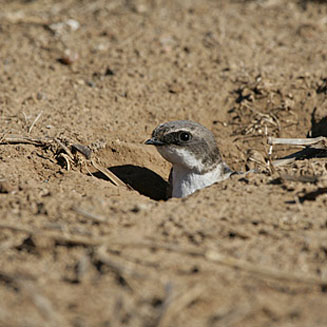|
Pseudhirundo griseopyga
(Grey-rumped swallow)
Gryskruisswael [Afrikaans]; Sisampamema (generic term
for swallows, martins, swifts and spinetails) [Kwangali]; Nyenganyenga (generic
name for swallow or martin) [Shona]; Grijsstuitzwaluw [Dutch]; Hirondelle à
croupion gris [French]; Graubürzelschwalbe [German];
Andorinha-de-rabadilha-cinzenta [Portuguese]
Life
> Eukaryotes >
Opisthokonta
> Metazoa (animals) >
Bilateria >
Deuterostomia > Chordata >
Craniata > Vertebrata (vertebrates) > Gnathostomata (jawed
vertebrates) > Teleostomi (teleost fish) > Osteichthyes (bony fish) > Class:
Sarcopterygii (lobe-finned
fish) > Stegocephalia (terrestrial
vertebrates) > Tetrapoda
(four-legged vertebrates) > Reptiliomorpha > Amniota >
Reptilia (reptiles) >
Romeriida > Diapsida > Archosauromorpha > Archosauria >
Dinosauria
(dinosaurs) > Saurischia > Theropoda (bipedal predatory dinosaurs) >
Coelurosauria > Maniraptora > Aves
(birds) >
Order: Passeriformes > Family: Hirundinidae
Distribution and habitat
Localised in West Africa, with the bulk of its population
extending from Uganda through the eastern DRC, Zambia, Angola, Malawi and
northern Mozambique to southern Africa. Here it is scarce to locally common in
Zimbabwe, northern Botswana, extreme northern Namibia, southern Mozambique,
Swaziland and the eastern areas of Limpopo Province, Mpumalanga and
KwaZulu-Natal. It is most commonly seen over flood plains, expansive woodland
clearings and short or burnt sandy grassland, especially near water. It also
occurs in ploughed fields, bare ground at vlei edges and sports fields.
|
 |
|
Distribution of Grey-rumped swallow in southern
Africa, based on statistical smoothing of the records from first SA Bird
Atlas Project (©
Animal Demography unit, University of
Cape Town; smoothing by Birgit Erni and Francesca Little). Colours range
from dark blue (most common) through to yellow (least common).
See here for the latest distribution
from the SABAP2. |
Movements and migrations
Mostly resident in northern Namibia, South
Africa and Mozambique but partially migratory in Zimbabwe. here its
generally much more scarce from October-April and can be completely
absent during wet summers.
Food
It eats aerial insects, especially flies (Diptera),
termite alates and beetles (Coleoptera),
usually foraging about 8 metres above ground, sometimes over open water. It
often hawks prey flushed by tractors, fires and even military explosives.
Breeding
- Monogamous, solitary or loosely colonial in groups of about 3-10 breeding
pairs.
- The nest is an untidy platform built of dry grass, flower heads and
stems, placed in a chamber at the end of a 0.6-1.0 metre long tunnel. It
usually uses old rodent burrows on bare ground, such as in burnt grassland,
at the edge of pans and even on sports fields. It may also use a deserted
kingfisher or
Little bee-eater burrow.
 |
|
|
Grey-rumped swallow in its burrow, Pafuri, South
Africa. [photo Warwick Tarboton ©] |
|
- Egg-laying season is from April-November, peaking from
June-August.
- It lays 2-5 glossy white eggs, the shape of which may, vary even within
a clutch from stumpy to long and pointed.
Threats
Not threatened, in fact it may have benefited from
deforestation and overgrazing as it favours open bare ground. s
References
-
Hockey PAR, Dean WRJ and Ryan PG 2005. Roberts
- Birds of southern Africa, VIIth ed. The Trustees of the John Voelcker
Bird Book Fund, Cape Town.
-
Harrison, J.A., Allan, D.G., Underhill, L.G., Herremans, M.,
Tree. A.J., Parker, V. & Brown, C.J. (eds). 1997. The atlas of southern
African birds. Vol. 2: Passerines. BirdLife South Africa, Johannesburg.
|
